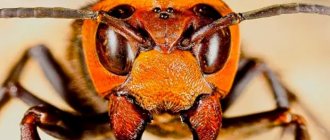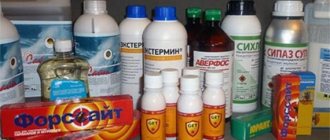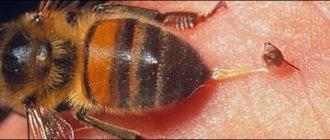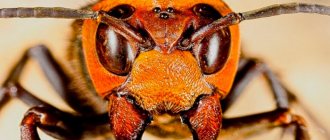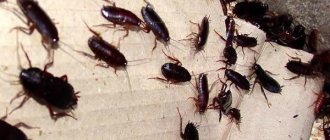Does the wasp bite or sting?
The wasp has not only a sharp sting, but also strong, strong jaws. When defending against enemies or hunting, a predator does not always sting; it often uses its mouthparts, with which an adult easily bites through the chitinous shell of insects. But when attacking a person, wasps always use a sting, with which they inject poison into the wound. Moreover, an insect can sting several times in a row without any harm to itself.
The structure of a wasp sting
If you examine under a microscope what a wasp sting looks like, the first thing that catches your eye is an absolutely smooth surface, without any jagged or rough edges. Essentially, a wasp sting is a long, thin, durable and very sharp needle made of chitin. Inside the sting there is a duct that is connected to a gland that produces a toxic substance. At the moment of danger, the iron produces a portion of poison that flows through the channel and enters the victim’s blood through a puncture in the skin. In its normal state, the sting is practically invisible, because it is retracted into the abdomen of the wasp.
Sting
Does a wasp leave a stinger after stinging?
As a rule, the wasp bites the victim without risking anything. Since the wasp's sting is smooth, after a bite the insect effortlessly removes it by contracting its muscles and either hides it or uses it for a second attack. So not only does the wasp not die after being bitten, it is able to use the sting dozens of times throughout its life.
Of course, there are situations when an insect is left without a sting, for example, if a large victim resisted and the sharp weapon broke off. But even in this case, there is most often no danger to the life of the insect.
Difference from a bee sting
At first glance, bee and wasp stings are similar in many ways, both in the reaction (severe pain, burning, swelling) and in the fact that a toxic substance enters the bloodstream. But there are also significant differences. The main one is that the bee bites only once, after which it dies, leaving a sting with a part of the torn off body at the site of the bite. It is unknown how many times a wasp can sting during its life; scientists believe that the number of bites is unlimited; in one attack, an insect can sting about 5 times.
Aspen venom differs in composition from bee venom, but despite this, both substances are used as a therapy for certain pathologies. Research is currently underway into the effects of the toxic substance secreted by wasps on cancer cells, which may help create a drug for the treatment of cancer.
Why do wasps attack people?
It should be noted that, unlike a bee, a wasp can attack a person more than once.
Bees can sting in self-defense, but then they die because the sting remains in the skin. Wasps have a smooth sting, so they are not in such danger. Only females sting. Wasps attack people if they sense danger. The problem is that by danger they can understand any innocent movement of a person.
In addition to single bites, there is also a danger of attack by several wasps, then the consequences of such an attack can be very serious. The human body can react differently to the poison that wasps secrete. Sometimes the damage is minimal, and after a few hours a person can forget about this trouble. However, there are cases when the victim requires hospitalization.
Signs of a wasp sting
The main symptoms of a wasp sting:
- burning pain in the affected area;
- skin redness;
- edema.
Bite
These signs appear in everyone, but sometimes an allergy occurs, which manifests itself as follows:
- severe swelling spreading far beyond the bitten area;
- itching;
- rash;
- labored breathing;
- too fast or slow pulse;
- dizziness, weakness;
- high temperature, fever, chills;
- nausea, vomiting.
In a healthy person, symptoms disappear 1 to 3 days after he was attacked by wasps. But it also happens that recovery takes several weeks.
Why is a bite dangerous?
Wasp venom contains a large number of toxins that can affect the human body in different ways:
- Acetylcholine;
- Histamine;
- Phospholipase enzymes;
- Cytotoxin;
- Glycemic index.
The first substance irritates the nerve endings, which is why the bitten person feels severe pain at the moment when the insect has not yet pulled its sting out of his skin. Histamine provokes an allergic reaction to the bite, resulting in swelling at the site of the bite.
Phospholipase triggers an inflammatory process in the body, which tries to get rid of damaged cells and toxins. In addition, phospholipase provokes a secondary allergy due to the fact that some cells begin to release their histamine, which enters the blood. This is the main danger of a wasp sting.
Cytoxin destroys the walls of small blood vessels, resulting in hemorrhage. Usually after a bite there is a slight bruise on the skin. If a person is attacked by several wasps at once, the consequences can be more serious, including internal hemorrhage.
Wasp stings lead to increased blood sugar. Shortness of breath, interruptions in heart function, and decreased blood pressure may also occur.
In addition to the poison that enters the human body through a bite, a wasp attack is also dangerous because these insects like to look for food where garbage or carrion lies. Therefore, the wasp is capable of causing an infection, which can cause a focus of purulent processes to appear in the affected area.
We suggest you read: How long does it take to steam cauliflower?
The last, but most serious danger to the human body from wasp stings is an allergic reaction. It can be of varying degrees of severity: from mild malaise to anaphylactic shock.
The severity of the bite depends on which insect attacked the victim. Usually there are three predators:
- Paper wasp;
- Hornet;
- Road wasp.
Fortunately, people usually encounter the first type of wasp, the consequences of whose bites are not so severe compared to the attacks of hornets and road wasps.
First aid
To reduce the unpleasant consequences of a wasp sting, the victim should be given first aid as quickly as possible:
- carefully examine the bite site; if there is a sting left in the wound, remove it with tweezers;
- treat the wound with a disinfectant;
- apply ice;
- take an antihistamine.
The person who has been bitten is advised to drink plenty of fluids (preferably clean water) in order to remove toxins from the body as quickly as possible.
How to quickly relieve swelling and redness?
The wasp bite hurts, and the affected area quickly swells and turns red. Special medications help reduce pain and unpleasant symptoms, but if they are not at hand, you can use:
- activated carbon (several tablets are dissolved in water, a cotton pad is moistened in the solution and applied to the wound);
- a gruel of chopped parsley relieves itching, swelling and inflammation;
- Plantain juice promotes rapid regeneration and relieves swelling.
The easiest way is to apply a cold compress or simply hold the bitten area under running cold water.
What to do if the insect sting remains in the wound: first aid
Wasps and hornets are the most aggressive insects and they can sting at the slightest provocation, at the slightest suspicion of their threat, unlike bees, which are much less aggressive and which most often sting when they are stepped on, sat on, accidentally grabbed or outright encroached upon to their home. The main sign of a bee sting, as mentioned above, is that it leaves a sting in the skin. The poison from the gland sac enters the human body for more than a minute. And the only sign of a wasp or hornet sting is the skin puncture point. After being stung by insects, the area around the wound quickly turns red and a seal forms around it under the skin (this collects fluid under the skin). It resolves after a few hours, but may remain itchy for more than 24 hours. Poisons injected when stung by insects vary in their chemical composition. Wasp venom is not alkaline, and bee venom is only slightly acidic. The chemical composition of these poisons is more complex than is believed, and therefore traditional treatment after a wasp sting with vinegar and a solution of soda after a bee sting brings only minor relief.
How to treat a bee sting.
When stung by a bee, it is necessary to remove the sting from the wound as quickly as possible to reduce the pain. This is done carefully, using tweezers, a knife or nails. The wound should be washed with soap and water. A cold compress, such as ice wrapped in a cloth, is then applied to the wound to reduce swelling. Ointments and balms, including anti-inflammatory and wound-healing ones, also help well after treating a wound (for example, rescue ointment and balm).
To reduce itching, you need to apply antihistamine cream to the stung area or take an antihistamine tablet orally. You can also use sunburn remedies to cool the wound and relieve itching. If the itching is very severe, then you need to see a doctor to get a steroid ointment. There may be more swelling around the wound. If the swelling is very large or does not go away for a long time, then you should definitely consult a doctor.
How to remove the sting?
Bees bite much more often than wasps. Therefore, a stung person cannot always accurately determine who attacked him. A wasp sting very rarely remains in the human body. This is only possible if it breaks off. The site must be inspected immediately. Since the wound swells quickly, examination will not yield results after a few minutes.
You should immediately treat the wound and apply cold to reduce swelling. If it is impossible to examine and remove the sting on your own, then you should seek help. To remove it you will need a magnifying object, good lighting and tweezers. Having grabbed the head, you should immediately pull the sting out of the wound.
Don't try to squeeze out the poison. There is a high probability that it will go deeper into the skin and enter the blood. This can lead to a serious inflammatory process.
Allergic reaction
The action of immunoglobulins in a healthy body can neutralize the effect of poisons. Its production begins immediately after the foreign substance enters the body.
If the person bitten is allergic to wasp venom, the reaction to the bite may be unpredictable. You can distinguish an allergic reaction from a normal one by the location of the bite. The first thing that will confirm the guesses is large swelling, more than 1 cm in diameter. The further occurrence of reactions depends on the human body.
Interesting! Allergy sufferers are issued special passports indicating personal data, allergen tests and first aid measures.
Allergy symptoms also:
- rash;
- strong pain;
- burning, itching;
- hives.
In addition to local reactions, the following may appear:
- headache, dizziness;
- nausea;
- decrease in blood pressure;
- difficulties with the breathing apparatus;
- elevated temperature;
- pale skin;
- muscle spasm.
The manifestation of the listed symptoms can begin within 20 minutes after the sting.
Anaphylactic shock that develops within the first 5 minutes is a strong and dangerous reaction of the body. It begins with difficulty breathing and swelling of the larynx. If such a reaction occurs, immediate medical attention must be provided. Prednisolone and adrenaline are administered, and a tourniquet is applied above the wound. Further treatment is carried out in a hospital setting.
When should you call an ambulance?
You should immediately call an ambulance if any of the following symptoms appear after a sting:
- swelling around the throat, mouth, or tongue that makes breathing or swallowing difficult;
- wheezing, as well as shortness of breath or difficulty breathing;
- weakness, fainting, dizziness or headache;
- any chest pain;
- nausea, stomach cramps, vomiting.
Attention! It must be remembered that an allergy to poison can begin to develop at any time.
People who have been stung two or more times in recent years have the highest risk of developing allergies. There is also another risk group - those who suffer from other forms of allergies (to pollen, animal dander, etc.). You should also definitely call an ambulance in case of a massive insect sting, if it’s not just one or two stings, but a swarm.
How to help at home?
If there are no medicines at hand, folk remedies that can be found in every home can help. By the way, natural remedies will also come in handy if a wasp has bitten a pregnant woman, for whom the list of approved medications is very limited. More often than others, the following are used to treat the bite site:
- aloe juice or pulp;
- a slurry of soda mixed with water;
- sour fruit (lemon, sour blocks);
- diluted apple cider vinegar;
- tomato pulp (both ripe and green);
- grated fresh potatoes.
Grated potatoes
Some housewives advise adding chopped onion or garlic, but the juice of these plants is very caustic, so the method is not suitable for everyone. In particular, such lotions are not recommended for treating wasp stings during pregnancy
How a wasp uses its sting
You should always remember that the wasp is a very aggressive insect that can sting at the slightest disturbance.
The structure of a wasp.
We will take a closer look at how this process occurs:
- Initially, the insect is affected by some irritating smell or she sees that someone is very close to the nest and a threat may come from him. In other words, it defines the victim.
- The wasp is on the warpath. She flies towards the enemy and at this moment the sting is still hidden in her abdomen.
- When a yellow-black striped warrior flies up to an object, special muscles in his body contract and literally push the stinger out.
- Nature provides that before the poison enters the victim’s body, it is necessary for the sting to penetrate there to a certain depth. If the insect fails to do this, the poison will not be released from the special gland.
- If the wasp stings the victim at the prescribed distance, then a portion of poison is released from the poisonous gland. It, through a channel-duct located inside the sting, directly enters the body of the “enemy”.
- The insect leaves the victim, easily removing its weapon.
- The wasp does not immediately hide its sting back into its abdomen. She is ready to repeat her attack if she deems it necessary. The insect can sting 4-5 times in a row. In this case, each time a new portion of poison will be released.
When the insect is no longer going to sting, the sting returns to its place in the abdomen. During each penetration of a sharp organ, 02-03 mg of poison enters the enemy’s body. Wasp stings are more painful than bee stings.
For many people, even one portion of the poison causes a severe allergic reaction, and several can be fatal.
What to do depending on the location of the bite?
A wasp can sting any part of the body. First aid will vary slightly depending on where the affected area is:
- the wasp has bitten the lip or tongue - the victim should take an antihistamine, you can let him suck on ice;
- if a wasp stings your eye, you should apply a napkin moistened with cold water, but it is better not to use ice, so as not to chill the facial nerve;
- If you are bitten on the neck, you should immediately take an antihistamine.
The most dangerous are wasp bites to the eye, neck, and tongue. In this case, you should immediately consult a doctor.
What is a wasp sting?
The wasp sting is an ovipositor, which in the process of evolutionary development became harder and connected with the poisonous gland, thereby transforming into a multifunctional organ.
The female can use the sting to:
- protect yourself and the nest from “enemies”;
- get food for the larvae and yourself.
Wasps sting insects and inject a dose of poison into their body, which does not kill, but only paralyzes. Therefore, during a meal, the minke whale eats only live meat and does not feed on corpses. You should know that during a hunt the victim is bitten by a wasp. She has very powerful jaws, which allow her to bite through the tough covering of beetles and other insects.
Thus, only females have a sting. Males cannot have stingers due to their anatomical structure. After all, the ovipositor is exclusively an organ of female individuals.
But you should know that male wasps appear only in late summer or early autumn, when mating occurs. They live very short - two to three weeks. Therefore, most of the wasps that you encounter in the summer are females that have a sting and are ready to sting a person painfully.
Allergy from wasp sting
An allergic reaction can occur in both experienced allergy sufferers and those who have previously endured insect bites without pain. In the most severe cases, swelling of the tongue and larynx develops, the person suffocates and loses consciousness.
Medications
To prevent the development of allergies, the stung person must take special medications:
- Suprastin;
- Cetrin;
- Tavegil.
Suprastin
For local application use: Psilo-balm, Fenistil gel, Rescuer.
What should you not do?
To avoid worsening your condition, the person who has been bitten should not:
- comb or rub the wound;
- smoke immediately after the bite;
- apply iodine and brilliant green directly to the wound.
Incorrect treatment can cause complications.
What to do if anaphylactic shock occurs?
If the condition is serious, you must immediately call an ambulance and try to alleviate the victim’s condition so that he does not die before the doctors arrive:
- lay down with legs raised;
- unbutton your clothes to make breathing easier;
- give an antihistamine.
If a person has lost his life or is not breathing, it is necessary to perform artificial respiration and cardiac massage.
What should you never do?
After a wasp sting, it is prohibited:
- try to squeeze the poison out of the wound;
- drinking alcohol;
- cauterize the wound;
- treat the bite site with hormonal agents.
Wrong actions in the event of a wasp sting can lead to a sharp deterioration in health, and the person may even die.
Wasps (bees and true wasps): general information
People who do not understand the intricacies of the structure of insects sometimes find it difficult to determine the difference between a wasp and a bee. Although they are similar in appearance, there are clear differences between them:
- The wasps look brighter, the stripes are bright yellow;
- They are capable of stinging several times, while bees, having bitten once, leave the sting in the body;
- Wasps feed on flower nectar, and bees feed on honey;
- Bees build honeycombs as a home, and wasps live in nests made of grass or paper;
- Bees are vegetarians by nature, while wasps do not disdain insects and larvae;
- The queen of the bee family spends the winter in the nest with increased attention and care of her relatives, and the queen of the wasp spends the winter alone.
When meeting an insect, you can determine its identity by external signs:
- Bees have a discreet color compared to their relatives;
- The wasp's body is elongated, with a clear notch under the chest;
- The yellow stripes of the predator are wider and more noticeable;
- The wasp lacks a fur coat on the upper part of its body;
- Wasp wings are located on the sides, while bee wings are more shifted to the center of the back;
- The wasp's horns are large and black.
If you encounter a wasp, be attentive and careful. It can cause you significant harm.
Insects use their stings for hunting, as well as self-defense and protection of the hive. Bees are not known for their aggressive disposition; they use their stings in emergency situations. Once stung, they continue to live for about 30 minutes. The bee sting has serrations that resemble a saw in appearance. Easily penetrates the skin, but cannot move back. After the jerk, the bee leaves the sting inside along with part of the abdomen. A few minutes later he dies.
Whether an insect dies or not - under such circumstances, no. Continues normal life activities and returns to the hive. However, it takes some time to recuperate. The wasp uses venom in special cases. When confronted with a potential victim, it uses its powerful jaws, and only then stings.
Bees leave their sting in the wound and die after being stung. Wasps do not leave a sting in the wound and can sting several times in a row. Honeybees (Apis mellifera), bumblebees (Bombus spp.) and other bees sting to protect their colonies.
Attention!
However, the so-called Africanized bees (a hybrid of European and African varieties of Apis mellifera) are very aggressive and attack humans at the slightest hint of danger.
Of the true wasps, there are the Vespula maculifrons wasp and the Vespula pensylvanica wasp (their abdomen is colored with transverse yellow and black stripes), the Dolichovespula maculata wasp, or spotted wasp (black, with a white head), the Vespa crabro wasp, or the common hornet (reaching a length of 2. 5-3.5 cm), and wasps Polistes spp., or paper wasps (having an elongated abdomen of different colors).
Real wasps sting to defend their nests. They often build nests near human dwellings, hanging them from roofs and eaves or gluing them to walls.
Some of them nest in tree hollows and in the ground. Wasps of the genus Vespula are hungry for sweets, and they are also attracted to rotten meat. There are especially many of them in late summer and autumn, particularly around kitchens and garbage dumps.
The venoms of different species of Hymenoptera differ from each other in biochemical and immunological properties. The toxic effect of poisons is due to low molecular weight components - serotonin, histamine, acetylcholine, kinins.
The polypeptide fraction of bee venom is represented by melittin, which damages cell membranes, MCD peptide, which causes degranulation of mast cells, adolapin, which has an anti-inflammatory effect, and the neurotoxin apamin.
In addition, bee venom contains hyaluronidase, which promotes the spread of venom throughout tissues, and phospholipases, which appear to be the main allergens of the venom. Bee venom rarely cross-reacts with the venom of real wasps.
We invite you to familiarize yourself with: Golden volodushka medicinal properties and contraindications
Important!
The reaction to a sting is usually manifested by pain, the appearance of a blister and hyperemia, and swelling of the surrounding tissues. Symptoms disappear after a few hours. Insect stings that accidentally enter the mouth are dangerous due to swelling and obstruction of the upper respiratory tract.
Multiple stings are sometimes accompanied by vomiting, diarrhea, extensive swelling, shortness of breath, hypotension and shock. Rhabdomyolysis and intravascular hemolysis can lead to renal failure. When stung by 300-500 bees at the same time, death occurs due to intoxication.
Swelling and hyperemia often spread to an area exceeding 10 cm in diameter and persist for 24-48 hours. Such reactions to stings superficially resemble erysipelas.
However, they are not caused by a secondary infection, but by increased sensitivity to the venom of Hymenoptera. With subsequent stings, the picture usually repeats, but anaphylactic shock is unlikely. Desensitization in such cases is ineffective.
Hymenoptera stings cause immediate allergic reactions in 0.4-4% of the US population. Approximately 15% of the population tests positive for skin tests with hymenoptera venoms, indicating sensitization. Individuals with a history of severe allergic reactions to stings are prone to developing such reactions later.
In persons with a history of mild allergic reactions, severe reactions are possible with new stings. Mild allergic reactions of the immediate type are manifested by nausea, cramping abdominal pain, generalized urticaria, hot flashes, and Quincke's edema.
Severe reactions are manifested by swelling of the upper respiratory tract, bronchospasm, arterial hypotension, anaphylactic shock and pose a threat to life. They usually begin within the first 10 minutes after a sting, but occasionally occur after 5 hours.
Serum sickness, vasculitis, neuropathies and encephalitis are among the unusual complications that can develop days and weeks after the sting.
Preventing wasp stings
To avoid a wasp sting, you need to know why these insects attack people and be careful. You need to be especially careful:
- having a picnic in nature;
- pruning fruit bushes and trees;
- picking berries or fruits, especially in the second half of summer;
- being in a wooden shed, in an attic, in a bathhouse;
- throwing garbage into a street container.
A wasp attack can be provoked by a sugary sweet aroma or the smell of food. When insects appear nearby, you must behave calmly, do not wave your arms, otherwise she will begin to defend herself.
Why do wasps bite and how to get rid of a dangerous neighborhood?
But you shouldn’t lose your vigilance, insects are different - harmless and aggressive, with an intelligent nature and a bandit.
The former fly past a person and do not pay any attention to him, the latter simply consider it their duty to glare at the first person they come across, relaxing in the spring sun.
Bees and bumblebees can be classified as intelligent - they never attack a person without reason. But hornets and wasps are real aggressors, stinging just like that, depending on their mood.
The reason for such aggression has not been clarified by science, but interesting facts have been established. Bees' stings have tiny serrations, making it impossible to remove them from human skin.
Therefore, having stung, a bee loses not only its sting, but also part of its stomach, which is incompatible with life - after a sting, it inevitably dies.
Wasps and hornets have a smooth, sharp sting that easily penetrates the skin and back, so these insects can bite repeatedly, each time injecting a certain dose of poison into the victim.
And one more inexplicable, but experimentally confirmed fact: angry bees and wasps are more likely to attack those who are allergic to their stings. How they recognize this is a mystery to scientists.
Unwanted neighbors
Depositphotos
There are a large number of species of wasps; they can lead a solitary lifestyle (road wasps and burrowing wasps make burrows in the soil; carpenter wasps make holes in wood) and live in large families that create special nests.
Most often, forest wasps build nests in the branches of trees and bushes, and representatives of the wasp species build nests under the roofs of houses, in sheds, and attics. It is this species that most bothers people, settling in the neighborhood and laying claim to the territory it occupies.
They are the ones that are found on sweet, ripe fruits in the garden and circle over the kitchen table, attracted by some smell.
The wasp nest is built in the spring, choosing a secluded place. The overwintered female queen does this - she builds a nest patiently and carefully, cell by cell, lays eggs in it and feeds the larvae. The larvae grow and pupate, and soon young worker wasps are born.
With their appearance, the female stops flying out of the nest and getting food, now she only breeds new offspring, and the worker wasps feed her and the new larvae, expanding the nest.
The temperature inside the nest is maintained at about 30 degrees, and under favorable conditions, by autumn the colony of wasps can reach several hundred individuals. In the fall, males and females emerge from the cells, but only fertilized females remain to spend the winter, and the males and worker wasps die.
Future queens spend the winter in secluded places and in the spring become the founders of new colonies. Depositphotos
On the one hand, wasps do a lot of useful things: pollinating flowering plants and exterminating harmful insects. But on the other hand, their aggression and bites pose a danger to human health.
If you find this unpleasant neighborhood in your dacha, try to get rid of it. If possible, contact the Ministry of Emergency Situations, the called team will do everything.
If this is not possible, you will have to fight insects yourself.
All manipulations to remove the nest should be done in the evening, at dusk, when the wasps fly in for the night. At this time, there is a greater chance of avoiding bites and eliminating the entire family at once, because during the day, at the slightest attempt to disturb the nest, you can be subjected to a massive attack by its defenders, with very dire consequences.
Take a large, strong plastic bag, apply any insecticide inside, carefully place the bag on top of the nest (in other words, place the nest in the bag) and tie it tightly, leaving everything like that for at least a day. After this, you can remove the nest along with the dead wasps and preferably burn it. At least for one season you will be free from these little flying terrorists.
If the wasps do not give rest, but their nest cannot be found, then you can try to reduce their number with the help of baits.
The top conical part of the plastic bottle is cut off and, turning the neck down, inserted back into the remaining part of the bottle, where sweet syrup or jam juice is poured. The bottles are placed in areas with the greatest concentration of wasps, and the solution is periodically updated.
Wasps actively crawl inside for a sweet treat, but can no longer get out and die in large numbers. Depositphotos
By the way…
Doctors say that the body’s violent reaction to the first bite of a stinging insect in life does not mean that from now on a person will certainly become allergic to such bites. The chances are 50 to 50. Half will react just as violently, and half, after subsequent bites, will get off with a completely normal reaction - the bite site will swell, turn red, hurt, itch, and go away.
A wasp stings: how does it happen?
How a wasp bites from the point of view of body structure was described in the previous section. However, it is also worth noting the fact that, despite the presence of fairly sharp stilettos, not every victim will be too tough for the insect, as they say. In order for the sting to be successful, the opponent’s integument must be softer than the sting itself; it is for this reason that wasps very rarely attack beetles, since their body is protected by rough elytra. Spiders are another matter; even the most poisonous and dangerous wasps can be dealt with quite simply.
As for whether the wasp leaves a sting when it bites, the answer will be negative, since its stylets are absolutely smooth, and therefore the insect can freely remove them from the victim’s body. Moreover, sometimes this insect can inflict not one, but several bites in a row and remain completely unharmed.
On a note! Depending on the situation, the wasp can make from 1 to 5 injections with its sting and then keep it!
Having stung just once, the wasp injects about 0.4 mg of poisonous secretion into the victim’s body. It is easy to calculate what the portion will be for 2, 3, 4, and 5 injections. And the last figure will be quite large and dangerous, especially for people with allergies to insect bites, in particular to wasp stings.



